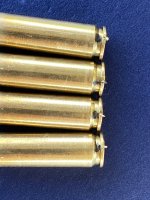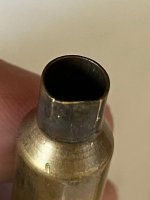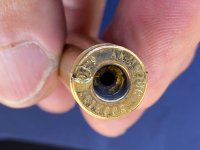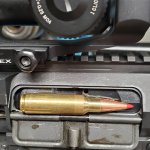I've looked through some of the previous posts about problems similar to mine, so I apologize if I'm rehashing an issue, but this is just different enough (to me anyway) to post it. I apologize in advance if I'm being repetitive.
And I need help.
Earlier this year I ordered, and received a Rock River LAR-BT3 in 6.5 Creedmore. Its intended purpose was to start PRS competition, since my son works with a guy that competes. The rifle is kept stock, except for a Vortex scope, and some weights for proper balancing.
I use only factory loaded ammo, since I don't have the time or patience for reloading. I've used Hornady 140 Match, Berger 144 Match (currently my choice), and Winchester 140 Match. I used Ammo Inc 140 Match for initial scope sighting to 200 yds (cheaper).
We were getting used to the rifle's performance at various distances, had shot about 400 rds through it, when we noticed a primer fell out of a fired case. The next few times it started happening more often, and the ejected cases started looking worse. That's when I started to try different factory loads as described above.
The signs are of EXTREME pressure. First I thought there was a carbon build up ring in the barrel/chamber. After a thorough chemical cleaning (left plugged barrel sit overnight with solvent), manual cleaning and rechecking I tried again: symptoms did not change.
Fast forward to experimenting with adjustable gas block, and more cleaning: nothing changed. Adjusted the gas block from full open to where it failed to extract: no real change. The fired brass was VERY difficult to manually extract with the gas closed off. I put original gas block back (since it worked fine in the beginning).
My last range outing for testing after ANOTHER thorough cleaning only showed me the problem is actually getting worse. Every ejected case is now missing the primer, and the rims are bent. Also noticed that accuracy has fallen off, from sub MOA to over 1.5 MOA. There's some damage from what I assume is the ejection port on the neck of the fired brass.
I should also note that I can easily chamber an unfired round with a gentle finger push, and the unfired case will readily fall out if I tilt the barrel and gently tap the rifle butt on a table.
I've tried reaching out to Rock River, but they're not answering my emails. The time I called and spoke with someone from Tech Support, they basically blew me off, blamed ALL the factory ammo as a "common industry problem", and "probably a dirty chamber/barrel". It really was a very insulting tone and conversation, so I thanked them for their time, and let it go. It seems I'm on my own here with an almost-new, expensive, non-functioning gas gun. If anybody knows who else to contact at Rock River Arms that would listen, that might help.
I'm expecting a set of Forster gauges tomorrow to check headspace. As to why headspace would change in a few hundred rounds, that's another question.
Anybody out there who can possibly help? I'm attaching a couple of pictures. You can also see neck damage on ejected brass, though it did that from the first day, before the over-pressure signs started.
Any answers are fully appreciated.
And I need help.
Earlier this year I ordered, and received a Rock River LAR-BT3 in 6.5 Creedmore. Its intended purpose was to start PRS competition, since my son works with a guy that competes. The rifle is kept stock, except for a Vortex scope, and some weights for proper balancing.
I use only factory loaded ammo, since I don't have the time or patience for reloading. I've used Hornady 140 Match, Berger 144 Match (currently my choice), and Winchester 140 Match. I used Ammo Inc 140 Match for initial scope sighting to 200 yds (cheaper).
We were getting used to the rifle's performance at various distances, had shot about 400 rds through it, when we noticed a primer fell out of a fired case. The next few times it started happening more often, and the ejected cases started looking worse. That's when I started to try different factory loads as described above.
The signs are of EXTREME pressure. First I thought there was a carbon build up ring in the barrel/chamber. After a thorough chemical cleaning (left plugged barrel sit overnight with solvent), manual cleaning and rechecking I tried again: symptoms did not change.
Fast forward to experimenting with adjustable gas block, and more cleaning: nothing changed. Adjusted the gas block from full open to where it failed to extract: no real change. The fired brass was VERY difficult to manually extract with the gas closed off. I put original gas block back (since it worked fine in the beginning).
My last range outing for testing after ANOTHER thorough cleaning only showed me the problem is actually getting worse. Every ejected case is now missing the primer, and the rims are bent. Also noticed that accuracy has fallen off, from sub MOA to over 1.5 MOA. There's some damage from what I assume is the ejection port on the neck of the fired brass.
I should also note that I can easily chamber an unfired round with a gentle finger push, and the unfired case will readily fall out if I tilt the barrel and gently tap the rifle butt on a table.
I've tried reaching out to Rock River, but they're not answering my emails. The time I called and spoke with someone from Tech Support, they basically blew me off, blamed ALL the factory ammo as a "common industry problem", and "probably a dirty chamber/barrel". It really was a very insulting tone and conversation, so I thanked them for their time, and let it go. It seems I'm on my own here with an almost-new, expensive, non-functioning gas gun. If anybody knows who else to contact at Rock River Arms that would listen, that might help.
I'm expecting a set of Forster gauges tomorrow to check headspace. As to why headspace would change in a few hundred rounds, that's another question.
Anybody out there who can possibly help? I'm attaching a couple of pictures. You can also see neck damage on ejected brass, though it did that from the first day, before the over-pressure signs started.
Any answers are fully appreciated.





